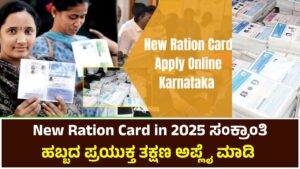New Ration Card in 2025 ಸಂಕ್ರಾಂತಿ ಹಬ್ಬದ ಪ್ರಯುಕ್ತ ತಕ್ಷಣ ಅಪ್ಲೈ ಮಾಡಿ
New Ration Card in 2025
Introduction to Ration Cards
Ration cards play a crucial role in the Indian public distribution system, ensuring subsidized food grains and other essentials to eligible households. Introduced as a mechanism to address food security, ration cards have evolved into multipurpose documents, often serving as proof of identity and residence. This guide outlines everything you need to know about applying for a new ration card in 2025, including eligibility criteria, document requirements, and step-by-step instructions.

1. Importance of Ration Cards
Ration cards serve two primary purposes:
- Access to Subsidized Essentials: The government provides rice, wheat, sugar, and kerosene at subsidized rates to cardholders.
- Identification: A ration card often acts as proof of residence and identity for various governmental and non-governmental purposes.
Additionally, ration cards are linked to numerous welfare schemes such as health benefits, educational support, and financial subsidies.
2. Eligibility for a New Ration Card
To apply for a ration card, you must meet the following criteria:
- You should not already possess a ration card in your name or household.
- Only Indian citizens are eligible.
- A newlywed couple can apply for a separate card.
- Migrants to a new state or district can apply for a ration card with updated details.
3. Types of Ration Cards
Each state offers different types of ration cards based on income levels and eligibility:
- APL (Above Poverty Line): For families above the poverty line with limited or no subsidy benefits.
- BPL (Below Poverty Line): For economically weaker sections eligible for maximum subsidies.
- Antyodaya Anna Yojana (AAY): For the poorest of the poor.
- Priority Household (PHH): Covers specific households identified by state criteria.
4. Required Documents for Application
The following documents are crucial for your application:
- Proof of Identity: Aadhaar card, Voter ID, PAN card.
- Proof of Residence: Utility bills, rent agreements, or property documents.
- Family Income Certificate: Required for BPL and AAY cards.
- Photographs: Passport-size photos of the applicant and family members.
5. Online Application Process
Step 1: Visit the Official Website
Access your state’s public distribution system portal. Some examples include:
- Karnataka: ahara.kar.nic.in
- Tamil Nadu: tnpds.gov.in
Step 2: Registration
Create an account using your mobile number or email ID.
Step 3: Fill Out the Application
Provide details like:
- Applicant’s name
- Family members’ details
- Income bracket
- Residential address
Step 4: Upload Documents
Attach scanned copies of required documents. Ensure the documents are in the prescribed format.
Step 5: Submit the Application
Upon submission, you’ll receive an acknowledgment slip with an application ID for tracking purposes.
6. Offline Application Process
If you cannot access the internet, follow these steps:
- Visit the Nearest Ration Office: Obtain the application form.
- Complete the Form: Provide accurate details of all family members.
- Attach Required Documents: Submit photocopies of necessary documents.
- Submit the Application: Hand over the form and documents to the designated officer.
7. Verification Process
- A field officer will visit your residence for document verification.
- Cross-checks will be conducted against existing records to avoid duplication.
8. State-Specific Guidelines
Some states have additional requirements:
- Karnataka: A BPL cardholder must submit an affidavit declaring income.
- Maharashtra: Online verification is faster, reducing approval times to 15 days.
9. Application Fees and Processing Time
- Fees: Most states provide the service for free, but a nominal fee may be charged for APL cards.
- Processing Time: On average, it takes 15-30 days for a new ration card to be issued.
10. Status Tracking
You can track your application status using:
- Online Portals: Enter your application ID on the state website.
- Helpline Numbers: States have toll-free numbers for inquiries.
11. Conclusion
The new ration card application process is designed to be inclusive and accessible, ensuring that no eligible household is left without essential benefits. By following the steps outlined above and ensuring accurate documentation, you can successfully apply for and receive your ration card.
